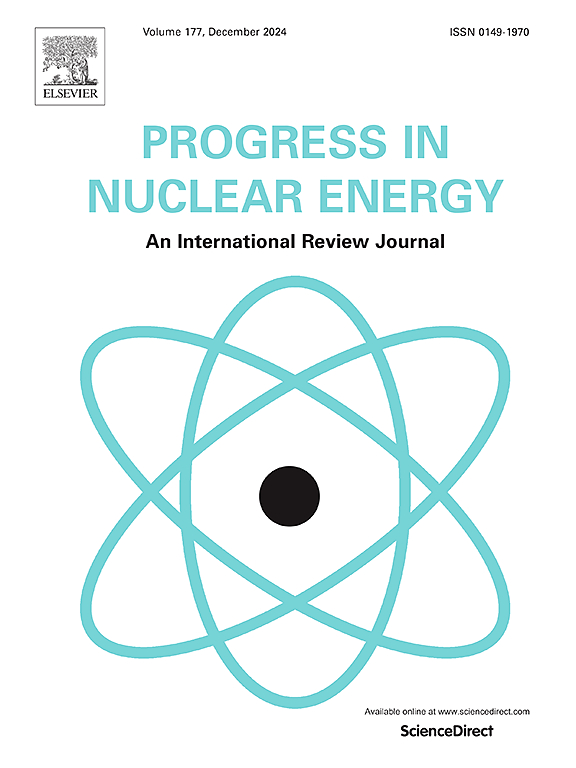Numerical & experimental study of single-phase flow in helically coiled pipes for laminar & turbulent regimes
IF 3.3
3区 工程技术
Q1 NUCLEAR SCIENCE & TECHNOLOGY
引用次数: 0
Abstract
The primary objective of this study is to conduct a numerical analysis of the single-phase friction factor in curved tubes, specifically concerning helical coil once-through steam generators designed for small modular reactors (SMRs). Numerical simulations were performed over a broad range of Reynolds numbers to encompass laminar and turbulent flow regimes.
As reported in the literature, helical configurations influence flow behaviour in contrast to straight tubes due to the introduction of centrifugal forces within the flow field. Hence, the impact of centrifugal forces on flow structure and the resultant pressure drop during laminar flow in helical coils with circular cross-section tubes has been systematically analysed for a wide range of coil pitch circle diameter (PCD) and helical pitch. This investigation examines the pressure drop across a helical coil through numerical simulations across an extensive range of Reynolds numbers. The numerical study is validated against the experimentally measured pressure drop over a wide range of Reynolds numbers. The friction factor derived from the numerical simulations is compared with predictions from various empirical correlations documented in the literature. A new empirical correlation for the estimation of single-phase flow through helical coils is proposed for the laminar regime, taking into account the effect of coil curvature as well as the pitch of the helix.
For the turbulent regime, three distinct turbulence models—k-ε, RNG k-ε, and Realizable k-ε—were evaluated, and their effectiveness in predicting pressure drop in helical coils was compared.
The findings indicate that centrifugal forces markedly affect the velocity profile across the cross-section of helical tubes. Similar observations were reported earlier by the author [36] for square cross-section helical paths with very tight curvature with d/D = 1/3. Here, the studies are carried out for d/D ranging from 1/12 to 1/70. Various combinations of pitch and coil PCD were studied during numerical analysis. The experimental studies were carried out for three different helical coil PCDs (150 mm, 339 mm & 877 mm) and two different pitch values (105 mm & 245 mm). Helical tubes exhibit a velocity maximum that shifts toward the extrados of the tube cross-section. This shift increases with the Reynolds number for a given coil diameter. An increase in velocity shift towards the extrados of the tube cross-section with an increase in Reynolds number is found to be significant for the ratio d/D considered in the study (1/12 to 1/70). In the case of turbulent flow, all three turbulence models—k-ε, RNG k-ε, and Realizable k-ε—employing standard wall functions yielded results that closely align with empirical correlations proposed by Ito and Mishra & Gupta, provided that the Y+ value is maintained above 11.25.
求助全文
约1分钟内获得全文
求助全文
来源期刊

Progress in Nuclear Energy
工程技术-核科学技术
CiteScore
5.30
自引率
14.80%
发文量
331
审稿时长
3.5 months
期刊介绍:
Progress in Nuclear Energy is an international review journal covering all aspects of nuclear science and engineering. In keeping with the maturity of nuclear power, articles on safety, siting and environmental problems are encouraged, as are those associated with economics and fuel management. However, basic physics and engineering will remain an important aspect of the editorial policy. Articles published are either of a review nature or present new material in more depth. They are aimed at researchers and technically-oriented managers working in the nuclear energy field.
Please note the following:
1) PNE seeks high quality research papers which are medium to long in length. Short research papers should be submitted to the journal Annals in Nuclear Energy.
2) PNE reserves the right to reject papers which are based solely on routine application of computer codes used to produce reactor designs or explain existing reactor phenomena. Such papers, although worthy, are best left as laboratory reports whereas Progress in Nuclear Energy seeks papers of originality, which are archival in nature, in the fields of mathematical and experimental nuclear technology, including fission, fusion (blanket physics, radiation damage), safety, materials aspects, economics, etc.
3) Review papers, which may occasionally be invited, are particularly sought by the journal in these fields.
 求助内容:
求助内容: 应助结果提醒方式:
应助结果提醒方式:


